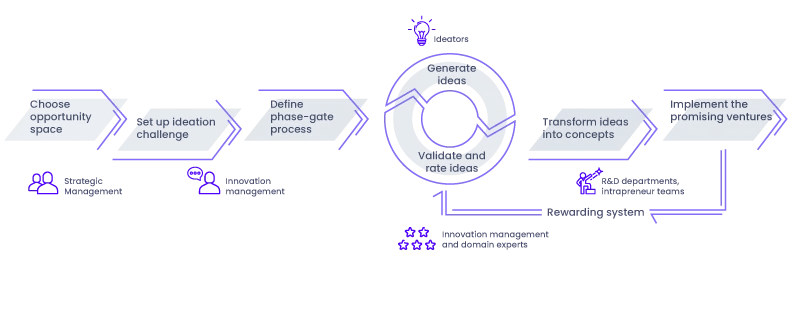From BMW’s sustainability hackathons to NASA’s crowdsourced space exploration solutions and Unilever’s open innovation calls, each serves as an example of how idea challenges have fueled real-world breakthroughs.
Whether inviting global talent, mobilizing internal teams, or partnering with universities, these diverse formats show how structured ideation can deliver measurable impact and accelerate innovation across industries.
This article contributes by breaking down when and how idea challenges work best, who should lead them, and the options available to fit different organizational needs. It offers practical steps, proven engagement tactics, and examples that illustrate measurable success, giving readers a clear, actionable framework to design and run their own high-impact challenge.

Summaries and FAQs on idea challenges
When do idea challenges support business goals?
Idea challenges deliver value when they are built around clear objectives and problem statements linked to strategic priorities.
Before starting the idea challenge, it is essential to answer key questions to identify the opportunity space, ensuring efforts are focused on areas with the greatest potential for innovation and growth. This structure channels new concepts toward outcomes that address real organizational needs, ensuring that time and resources are invested where they have the most impact.
Who should be the lead team member for an idea challenge?
Select a lead with strong project management skills, decision-making authority, and a sound grasp of both the creative work and business strategy.
They manage the challenge and keep it aligned with companies' goals.
What options exist to run an idea challenge?
Challenges fall into three categories. Companies can run open challenges inviting a broad solver group, or targeted events for specific teams or employees. In contrast to open challenges, targeted (closed) challenges focus on select groups, highlighting different approaches to ideation and collaboration.
Hybrid approaches can combine internal insight with external perspectives.
What are the best ways to encourage participation in an idea challenge?
Boost engagement with internal promotion, gamification, and recognition programs. Offer expectations and prizes upfront, and clearly explain how ideas will be evaluated and used. This transparency builds trust and commitment.
What are the 5 steps to run a successful idea challenge?
The five steps of a successful idea challenge are:
1. Define challenge goals and scope.
2. Promote widely to the intended audience.
3. Collect and manage submissions.
4. Evaluate entries using consistent factors.
5. Share results, provide feedback, and move winning ideas into initiatives with clear ownership and timelines.
Well-run challenges turn pitches into measurable innovation that benefits the entire organization.
What is an idea challenge, and why does it drive innovation
An idea challenge is a focused challenge that invites teams, students, or employees to submit creative solutions to a defined goal. Campaigns can be tailored for specific groups, such as undergraduate students, to solve real-world problems and develop teamwork skills.
By offering resources and clear criteria, companies can guide participants toward impactful outcomes. This encourages creative thinking and structured evolution of concepts into actionable projects, fostering a sense of community and collaboration.
Campaigns can focus on developing innovative services as well as products. Ideas are evaluated for feasibility and potential impact, ensuring only the strongest move forward. Such campaigns generate momentum, spark fresh thinking, and help companies adapt to changing markets.
When well-structured, they not only produce innovative solutions but also engage participants in meaningful, goal-driven competition that benefits the entire company culture.
Define the objective and scope of your campaign (Step 1)
Every successful campaign starts with a clear objective. Define the business goals that the campaign will support. Be specific about the outcomes you expect, such as new product concepts, continuous improvements, or innovative services.
Scope is equally important. Start by defining the business challenges the campaign will address. These should be rooted in systematic foresight, market trend analysis, or newly uncovered customer insights.
Collect these insights in a structured way, then prioritize them based on strategic fit. From there, frame the most pressing challenges and pitch them to the right challenge solvers.

Design the idea challenge format and rules (Step 2)
Once objectives and challenges are clear, decide how to pitch them to the right solvers.
Some campaigns work best as open innovation initiatives, inviting partners, customers, startups, or even the public. Others are targeted to specific teams with relevant expertise, cross-functional groups, or specialist communities such as universities and engineering programs.
You can also run a hybrid model, starting with a smaller group and opening up in later stages.
Choose a format that matches your goals, whether it is a short sprint, a multi-phase competition, or a rolling submission model. Set transparent rules and criteria for submissions. Clearly define which participants or teams are eligible to enter and win prizes, based on your competition's requirements.
Provide the resources participants need to contribute effectively, such as templates, examples, or access to subject-matter experts. Teams can pitch their ideas through a simple registration form, ensuring all participants are formally enrolled before the challenge begins.
/Still%20images/Workflows%20Mockups%202025/capabilities-workflows-embed-and-share-forms.webp?width=2160&height=1350&name=capabilities-workflows-embed-and-share-forms.webp)
State deadlines clearly and outline the evaluation guidelines, including who will review and how decisions will be made. Highlight the prizes available for winners, including the chance to win cash prizes, as key incentives to encourage participants to join the competition.
The more transparent, the stronger the trust and understanding.
Appoint and empower the lead team member and idea challenge owner (Step 3)
Assign a lead team member to own the campaign from start to finish. This person should have a strong understanding of the challenge objectives and the authority to make decisions. They will coordinate communications, track progress, and ensure deadlines are met with the teams.
Empower this role with access to key resources and decision-makers. The lead team member also acts as the link between participants and the evaluation panel, making sure feedback is delivered and plays into the next iterations. This accountability helps preserve the integrity of the process.
Engage and support participants throughout the campaign (Step 4)
Teams can only submit their ideas on an idea form when they know about the challenge.
Promote the challenge internally with regular updates and inspiring content. Let the best ideas compete against each other and reward the best with cash prizes. Introduce participants to ask questions and share ideas early. This builds awareness and keeps momentum high.
Offer feedback during the campaign to help participants refine their submissions. Recognize contributions publicly to make contributions rewarding. Encourage collaboration between teams to improve feasibility and leverage comments, likes, and supportive service to leverage synergies.
/Still%20images/Ideation%20Mockups%202025/ideation-gamify-and-reward-2025.webp?width=2160&height=1350&name=ideation-gamify-and-reward-2025.webp)
Review, select, and plan next steps for implementation transparently (Step 5)
Once submissions close, evaluate each idea against your stated criteria. Involve a panel of experts from different departments to ensure multiple perspectives and reduce bias. Share the evaluations, so all members understand how decisions are made.
Select the best concepts and share the reasons for their selection. Clearly outline actionable steps, including timelines, responsible teams, and resources allocated for implementation.
This transparency maintains trust and encourages teams to participate in the future. Follow up by tracking the progress of selected projects and providing public updates to the community.
How to measure the success of your campaign
To measure the success of your idea challenge, start by defining a clear structure and direction so participants know how to compete effectively.
Set measurable objectives, such as the number of ideas submitted, engagement rates, and implementation outcomes. Track the development of top ideas over time, from concept to execution.
The following questions are commonly used:
-
How many ideas were submitted per team/department/region
-
What is the ratio of approved ideas to total submissions?
-
What is the ratio of internal vs external ideas?
-
What is the average evaluation time per idea?
To create value, companies must also track the quality. KPIs might assess:
-
How many ideas align with strategic priorities?
-
How many result in funded innovation initiatives?
/Still%20images/Portfolio%20Mockups%202025/portfolio-optimize-portfolio-returns-2025.webp?width=2160&height=1350&name=portfolio-optimize-portfolio-returns-2025.webp)
Idea challenge template with the dos and don'ts
A clear idea challenge form sets expectations and ensures that the community knows what to deliver. It also helps teams gather ideas that address real business needs.
Using a standardized form ensures consistency and pitch comparability.
The dos
1. Define the challenge with clarity so participants know exactly what is expected.
2. Share the criteria for evaluation in advance so every submission is measured fairly.
3. Allow for easy registration and contact, open communication, and collaboration.
4. Provide resources and examples to guide participants toward relevant solutions.
5. Set realistic deadlines to allow thoughtful responses.
6. Encourage employees, students, or invited partners to participate and submit ideas connected to strategic goals with cash prizes or other prizes and constant communication.
The don'ts
1. Overcomplicate forms or use vague instructions that confuse participants.
2. Ignore comments or questions during the process. Maintain active communication.
3. Set overly strict rules that limit creativity or innovation.
4. Hide ideas from other teams and prevent concepts from competing against each other.
5. End the challenge without clear steps for implementation.
6. Overlook recognition for members whose thoughts were not selected but contributed value.
Best practices for running successful idea challenges
Successful idea challenges share a structured approach, clear objectives, and transparent workflows.
Cisco created and established the Innovate Everywhere Challenge to drive engagement and cultural change, reaching more than 36,000 employees across nearly 90 countries. The multi-phase process included submission, peer voting, and expert review, resulting in hundreds of viable ventures. Seed funding for the winners helped accelerate engineering implementation and foster a culture of innovation.
KSB connected more than 7,000 active users in one global network for idea sharing. This digital setup reduced processing times by 60 percent and increased collaboration across departments. Gamified incentives kept participation high, while transparent tracking maintained momentum from submission to execution. Their digital platform helped the organization operate efficiently by establishing roles, permissions, and transparency in its idea management.
KPMG’s Global Generative AI Innovation Challenge involved over 10,000 innovators across 100 countries. Generative AI tools supported idea generation, evaluation, and prioritization, producing actionable insights into new business opportunities.
These practices show the value of setting clear goals, enabling wide participation, and using technology to streamline the entire process from idea capture to project launch. Organizations that follow these approaches are better equipped to surface eligible ideas and convert them into impactful outcomes.
Run a successful idea challenge today with ITONICS, the best idea management software
The ITONICS Innovation OS is the most comprehensive platform designed to capture, share, and bring valuable ideas through systematic phase gate processes to production. With ITONICS, you can harness the full potential of ideation in a single, user-friendly system. Ensure your best ideas move beyond brainstorming sessions and turn into actionable innovations.
/Still%20images/Ideation%20Mockups%202025/ideation-organize-idea-flows-2025.webp?width=2160&height=1350&name=ideation-organize-idea-flows-2025.webp)
Streamline ideation: Managing a high volume of ideas from various sources can be overwhelming. ITONICS allows you to capture, evaluate, and prioritize ideas from across the organization, including customers and partners, all in one structured stage-gate process. This helps focus resources on the most impactful ideas and reduces time wasted on less promising ones.
Drive continuous improvements: Equip your organization like professional athletes and foster everyday improvement. Provide one central place to collect any idea, identify patterns, and get things done. Use transparent communication to implement routines and a sense of “each day better”.
Accelerate time-to-market: Gain unprecedented efficiency in innovation. The ITONICS Innovation OS saves time, reduces efforts, and accelerates time-to-market. When speed matters and time is money, reducing any administrative burden is what lets innovation leaders excel.







